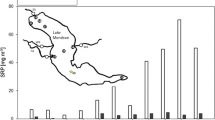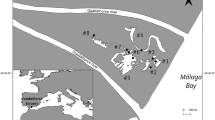Abstract
Automated in situ flow cytometry, high-pressure liquid chromatography (HPLC), optical microscopy and fluorometry were combined to monitor phytoplankton over two summer periods (2005 and 2006). In 2006, temperature was higher and nutrients lower than in 2005, generating differences in the phytoplankton assemblages (i.e., abundance and structure). Pigment-size classes based on daily HPLC analysis provided evidence for higher proportions of picoplankton and nanoplankton with higher biomass in 2005 and a dominance of microplankton with lower biomass in 2006, the latter with lower specific diversity, as evidenced by weekly microscopy analyses. Total chlorophyll a estimations from fluorometry measurements recorded every 30 min were higher in 2005 than in 2006, as for the HPLC chlorophyll a concentrations. An automated in situ flow cytometer (Thyssen et al., J Plankton Res 30(9):1027–1040, 2008a) sampled seawater every 30 min. Data analysis yielded the resolution of seven clusters based on light scatter and fluorescence. In 2006, an increase in abundance of the largest cells was observed, confirming pigment and microscopy data. The results suggest that the ecosystem was on a constant renewing process in summer 2005 due to a strong wind event and on a highly productive and recycling way in summer 2006 due to stratification of the upper water layer. Automated submersible flow cytometry confirms to be a powerful tool providing high-resolution data by monitoring phytoplankton at the single cell level. This technology gives access to the shape of the light scatter and fluorescence signals generated by each cell passing through a laser beam and that are linked to size, structure and pigment content of the target cell. When combined with conventional techniques, it further improves our understanding of phytoplankton assemblages.
Similar content being viewed by others
References
Barlow, R. G., Cummings, D. G., & Gibb, S. W. (1997). Improved resolution of mono- and divinyl chlorophylls a and b and zeaxanthin and lutein in phytoplankton extracts using reverse phase C-8 HPLC. Marine Ecology Progress Series, 161, 303–307.
Batten, S. D., Walne, A. W., Edwards, M., & Groom, S. B. (2003). Phytoplankton biomass from continuous plankton recorder data: An assessment of the phytoplankton colour index. Journal of Plankton Research, 25(7), 697–702. doi:10.1093/plankt/25.7.697.
Claustre, H. (1994). The trophic status of various oceanic provinces as revealed by phytoplankton pigment signatures. Limnology and Oceanograpy, 39(5), 1206–1210.
Duarte, C. M., Marrase, C., Vaque, D., & Estrada, M. (1990). Counting error and the quantitative analysis of phytoplankton communities. Journal of Plankton Research, 12(2), 295–304.
Dubelaar, G. B. J., Geerders, P. J. F., & Jonker, R. R. (2004). High frequency monitoring reveals phytoplankton dynamics. Journal of Environmental Monitoring, 6(12), 946–952.
Dubelaar, G. B. J., & Gerritzen, P. (2000). CytoBuoy: A step forward towards using flow cytometry in operational oceanography. Scientia Marina, 64(2), 255–265.
Dubelaar, G. B. J., Gerritzen, P., Beeker, A. E. R., Jonker, R., & Tangen, K. (1999). Design and first results of Cytobuoy: A wireless flow cytometer for in situ analysis of marine and fresh waters. Cytometry, 37, 247–254.
Dubelaar, G. B. J., Venekamp, R. R., & Gerritzen, P. L. (2003). Handsfree counting and classification of living cells and colonies. 6th Congress on Marine Sciences, Havana.
Ediger, D., Raine, R., Weeks, A. R., Robinson, I. S., & Sagan, S. (2001). Pigment signatures reveal temporal and regional differences in taxonomic phytoplankton composition of the west coast of Ireland. Journal of Plankton Research, 23(8), 893–902.
Gailhard, I. (2003). Analyse de la variabilité spatio-temporelle des populations microalgales cotières observées par le “REseau de surveillance du PHytoplancton et des phycotoxines” (REPHY). Marseille, Université de la Mediterranée, Aix-Marseille II, 180.
Garibotti, I. A., Vernet, M., Kozlowski, W. A., & Ferrario, M. E. (2003). Composition and biomass of phytoplankton assemblages in coastal Antarctic waters: A comparison of chemotaxonomic and microscopic analyses. Marine Ecology Progress Series, 247, 27–42.
Gieskes, W. W. C. (1991). Algal pigment fingerprints: Clue to taxon-specific abundance, productivlty and degradation of phytoplankton in seas and oceans. In S. Demers (Ed.), Particle analysis in oceanography (pp. 60–99). Berlin: Springer. G27.
Hasle, G. R. (1988). The inverted microscope method. P. manual ParisEds A. Sournia. UNESCO.
Havskum, H., Schlüter, L., Scharek, R., Berdalet, E., & Jacquet, S. (2004). Routine quantification of phytoplankton groups-microscopy or pigment analyses? Marine Ecology Progress Series, 273, 31–42.
Hillebrand, H., Durselen, C. D., Kirchttel, D., Pollingher, U., & Zohary, T. (1999). Biovolume calculation for pelagic and benthic microalgae. Journal of Phycology, 35, 403–424.
Hood, R. R., Laws, E. A., Armstrong, R. A., Bates, N. R., Brown, C. W., Carlson, C. A., et al. (2006). Pelagic functional group modeling: Progress, challenges and prospects. The US JGOFS Synthesis and Modeling Project: Phase III. Deep-Sea Research Part II: Topical Studies in Oceanography, 53(5–7), 459–512.
Irigoien, X., Meyer, B., Harris, R., & Harbour, D. (2004). Using HPLC pigment analysis to investigate phytoplankton taxonomy: The importance of knowing your species. Helgoland Marine Research, 58(2), 77–82.
Jacquet, S., Prieur, L., Avois-Jacquet, C., Lennon, J.-F., & Vaulot, D. (2002). Short-timescale variability of picophytoplankton abundance and cellular parameters in surface waters of the Alboran Sea (western Mediterranean). Journal of Plankton Research, 24(7), 635–651.
Jeffrey, S. W., & Vest, M. (1997). Introduction to marine phytoplankton and their pigment signatures. In S. W. Jeffrey, R. F. C. Mantoura, & S. W. Wright (Eds.), Phytoplankton pigments in oceanography (pp. 37–84). Paris: UNESCO.
Li, W. K. W., Harrison, W. G., & Head, E. J. H. (2006). Coherent Sign Switching in Multiyear Trends of Microbial Plankton. Science 11(5764), 1157–1160. doi:10.1126/science.1122748.
Lund, J. W. G., Kipling, C., & Cren, E. D. (1958). The inverted microscope method of estimating algal numbers and the statistical basis of estimations by counting. Hydrobiologia, 11(2), 143–170.
Mantoura, R. F. C., & Llewellyn, C. A. (1983). The rapid determination of algal chlorophyll and carotenoid pigments and their breakdown products in natural waters by reverse-phase high-performance liquid chromatography. Analytical Chimica Acta, 151, 297–314.
Martin, A. P., Zubkov, M. V., Burkill, P. H., & Holland, R. J. (2005). Extreme spatial variability in marine picoplankton and its consequences for interpreting Eulerian time-series. Biology Letters, 1, 366–369.
Olson, R. J., Shalapyonok, A., & Sosik, H. M. (2003). An automated flow cytometer for analyzing pico- and nanophytoplankton = FlowCytobot. Deep Sea Research Part I, 50, 301–315.
Pena, M. A. (2003). Plankton size classes, functional groups and ecosystem dynamics: An introduction. Progress in oceanography plankton size-classes, functional groups and ecosystem dynamics, 57(3–4), 239–242.
Rantajarvi, E., Olsonen, R., Hallfors, S., Leppanen, J.-M., & Raateoja, M. (1998). Effect of sampling frequency on detection of natural variability in phytoplankton: Unattended high-frequency measurements on board ferries in the Baltic Sea. ICES Journal of Marine Science, 55(4), 697–704.
Redfield, A. C. (1934). On the proportions of organic derivations in sea water and their relation to the composition of plankton. In James Johnson Memorial Volume, R.J. Daniel, University Press of Liverpool.
Reynolds, C. S. (2002). Towards a functional classification of the freshwater phytoplankton. Journal of Plankton Research, 24(5), 417–428.
Ribera d’Alcalà, M., Conversano, F., Corato, F., Licandro, P., Mangoni, O., Marino, D., et al. (2004). Seasonal patterns in plankton communities in a pluriannual time series at coastal Mediterranean site (Gulf of Naples): An attempt to discern recurrence and trends. Scientia Marina, supplement, 1(68), 65–83.
Sackmann, B. S., Perry, M. J., & Eriksen, C. C. (2008). Seaglider observations of variability in daytime fluorescence quenching of chlorophyll-a in Northeastern Pacific coastal waters. Biogeosciences Discusion, 5, 2839–2865.
Sakka Hlaili, A., Grami, B., Hadj Mabrouk, H., Gosselin, M., & Hamel, D. (1990). Phytoplankton growth and microzooplankton grazing rates in a restricted Mediterranean lagoon (Bizerte Lagoon, Tunisia). Marine Biology, 151(2), 767–783.
Schlüter, L., Møhlenberg, F., Havskum, H., & Larsen, S. (2000). The use of phytoplankton pigments for identifying and quantifying phytoplankton groups in coastal areas: Testing the influence of light and nutrients on pigments/chlorophyll a ratios. Marine Ecology Progress Series, 192, 49–63.
Shannon, C. E., & Weaver, W. (1949). The mathematical theory of communication. Urbana: University of Illinois Press.
Smayda, T. J. (1978). From phytoplankton to biomass.I Phytoplankton Manual. Monographs on Oceanographic Methodology 6. A. E. Sournia, Paris UNESCO.
Sosik, H. M., Olson, R. J., Neubert, M. G., & Shalapyonok, A. (2003). Growth rates of coastal phytoplankton from time-series measurements with a submersible flow cytometer. Limnology and Oceanography, 48(5), 1756–1765.
Ston, J., Kosakowska, A., & Lotocka, M. (2002). Pigment composition in relation to phytoplankton community structure and nutrient content in the Baltic Sea. Oceanologia, 44(4), 419–437.
Takahashi, T., Sutherland, S. C., Sweeney, C., Poisson, A., Metzl, N., Tillbrook, B., et al. (2002). Global sea-air CO2 flux based on climatological surface ocean pCO2, and seasonal biological and temperature effects. Deep Sea Research Part II: Topical Studies in Oceanography, 49, 1601–1622.
Thyssen, M., Mathieu, D., Garcia, N., & Denis, M. (2008a). Short-term variation of phytoplankton assemblages in Mediterranean coastal waters recorded with an automated submerged flow cytometer. Journal of Plankton Research, 30(9), 1027–1040.
Thyssen, M., Tarran, G. A., Zubkov, M. V., Holland, R. J., Gregori, G., Burkill, P. H., et al. (2008b). The emergence of automated high-frequency flow cytometry: Revealing temporal and spatial phytoplankton variability. Journal of Plankton Research, 30(3), 333–343.
Tréguer, P., & LeCorre, P. (1975). Manuel d’analyses des sels nutritifs dans l’eau de mer (Utilisation de l’Autoanalyser II). Brest, 2ème edn. Laboratoire de Chimie Marine. Université de Bretagne Occidentale.
Uehlinger, V. (1964). Etude statistique des méthodes de dénombrement planctonique. Archives des Sciences, 17(2), 11–223.
Veldhuis, M. J. W., & Kraay, G. W. (2000). Application of flow cytometry in marine phytoplankton research: Current applications and future perspectives. Scientia Marina, 64(2), 121–134.
Vidussi, F., Claustre, H., Bustillos-Guzman, J., Cailliau, C., & Marty, J.-C. (1996). Determination of chlorophylls and carotenoids of marine phytoplankton: Separation of chlorophyll a from divinylchlorophyll a and zeaxanthin from lutein. Journal of Plankton Research, 18(12), 2377–2382.
Vidussi, F., Claustre, H., Manca, B. B., Luchetta, A., & Marty, J.-C. (2001). Phytoplankton pigment distribution in relation to upper thermocline circulation in the eastern Mediterranean Sea during winter. Journal of Geophysical Research, 106(C9), 939–956.
Waters, R. L., Mitchell, J. G., & Seymour, J. (2003). Geostatistical characterisation of centimetre-scale spatial structure of in vivo fluorescence. Marine Ecology Progress Series, 251, 49–58.
Author information
Authors and Affiliations
Corresponding author
Rights and permissions
About this article
Cite this article
Thyssen, M., Beker, B., Ediger, D. et al. Phytoplankton distribution during two contrasted summers in a Mediterranean harbour: combining automated submersible flow cytometry with conventional techniques. Environ Monit Assess 173, 1–16 (2011). https://doi.org/10.1007/s10661-010-1365-z
Received:
Accepted:
Published:
Issue Date:
DOI: https://doi.org/10.1007/s10661-010-1365-z




